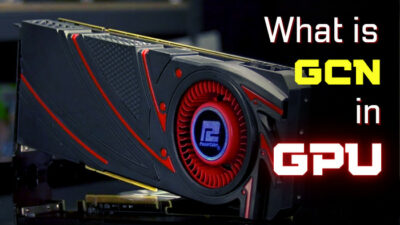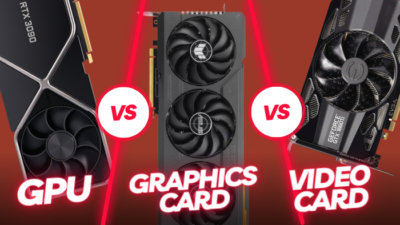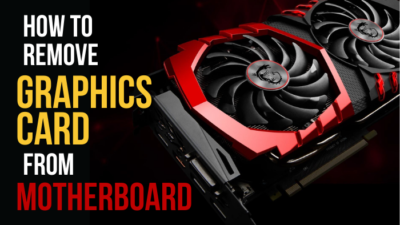Sometimes a decent laptop fails to satisfy your gaming needs when its GPU can’t handle minimum gaming requirements. If you get stuck in such a sad dilemma, I bet one question is poking into your mind!
Is it possible to upgrade the laptop’s GPU?
The answer is No! But you can go for an eGPU if your laptop supports that. In this article, I’ll cover both factors with in-depth explanations. So, stick to this article till the end line. Let’s break in!
Type of Graphics Cards in Laptops
Integrated & discrete are the two types of GPU graphics available for every laptop. The integrated one shares the same silicon die with the CPU, also known as iGPU. Whereas the discrete GPU has separate silicon die and specific PCB. And you can call it dedicated graphics, too.
Both CPU manufacturing giants Intel and AMD offer integrated graphics for laptops. The integrated GPU comes with the CPU and can handle minimal graphics-centric tasks and gaming.
Not all, but some AMD processors have an in-built graphics processing unit, which is known as APU. This naming might sound terrible, but those AMD Radeon graphics in the AMD processor lineup are best in class.
You can play mid-level games and graphics-related works with any latest Ryzen APUs. But if you’re thinking of changing this GPU, it’s not possible. And the same thing goes for Intel’s iGPU. You’ll get UHD 770 as iGPU with Intel’s 13th gen Raptor Lake processors.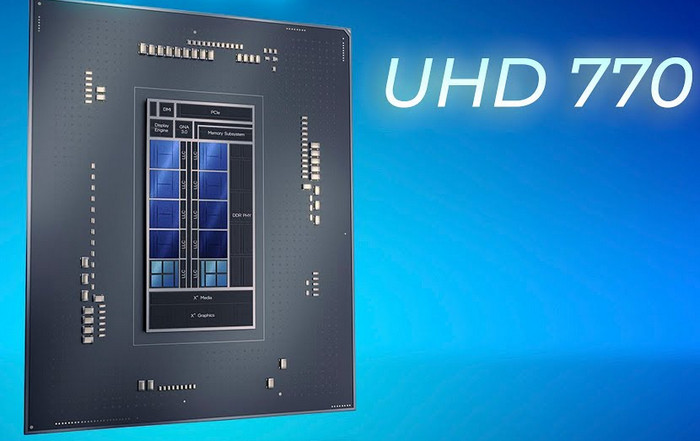
Conversely, the discrete graphics on the laptop are more powerful than the iGPU. It draws power from the laptop’s PSU unit separately from the CPU, like the desktop’s graphics card.
But if you compare the same model’s laptop dedicated GPU with the desktop one, you’ll find the desktop one is more powerful. For example, a desktop-grade 1660 Ti graphics card can outrun a laptop’s 1660 Ti card easily.
Nvidia card models’ names ending with Ti are more powerful than the basic ones. If you’re curious, search for what Nvidia Ti series GPUs offer and look at the specs. You’ll know for sure.
Desktop graphics cards connect with the motherboard with a PCIe port. But, in laptops, you won’t find any PCIe port for installing the GPU because it comes soldered with the motherboard’s PCB. That’s why it’s like a mission impossible to upgrade a laptop’s dedicated GPU.
GPU might start to fail after using it for a long. If that’s the case, you should test for a failing GPU. But the question is, can you upgrade the laptop’s GPU in case the current one is on the verge of expiration?
Let’s find out!
Can I Upgrade the Graphics Card in Laptops?
Changing a laptop’s graphics card isn’t possible yet because both integrated GPU & discrete GPU come soldered with the laptop’s PCB. Speaking of the iGPU, it’s part of the CPU. That’s why it’s impossible to change it. Additionally, you can’t also upgrade the laptop’s discrete GPU too.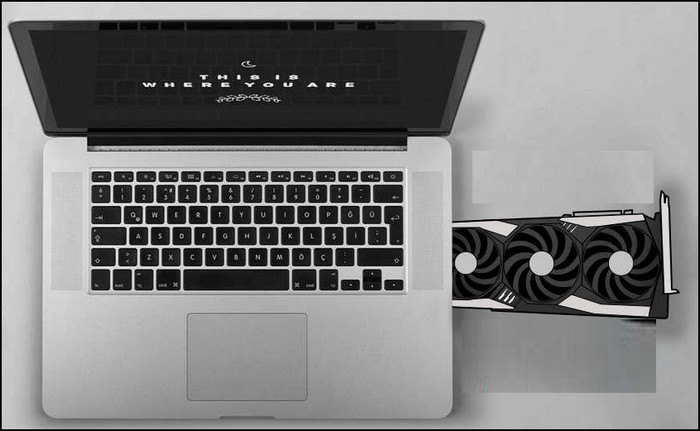
Gaming laptops come with a dedicated GPU, and those laptops are expensive. But the sad news is you can’t upgrade those discrete laptops’ GPU.
Modern games and graphics work requires tons of graphic processing. And if you’re a heavy gamer or professional graphics designer, you just need a laptop with a good dedicated GPU.
So, it’ll be wise to choose a laptop with a great GPU while buying one to avoid thinking of changing the GPU later.
However, some laptops, like Dell Alienware Area-51m, support upgrading the CPU & GPU. They use an MXM port for the GPU to connect with the motherboard. I’ll talk about MXM later in this article. Not only those laptops but also the MXM connector-based GPUs are more expensive. So, think twice!
Moreover, you can connect an external GPU to a laptop. But before getting into that, you must check if your GPU is working well by looking at its usage. If GPU utilization is below the line, you can apply several fixes to solve low GPU usage.
What are the Options to Upgrade the Laptop GPU?
If you own an expensive gaming laptop with an LGA socket for the CPU and an MXM slot for the GPU, you can upgrade both the processor & graphics card. But these laptops are super expensive. Moreover, you can use the laptop’s thunderbolt port to add an external GPU to the laptop.
Mobile PCI Express Module or short MXM is a connector slot for GPUs. You’ll find it on the laptop’s PCB board to mount the dedicated GPU. This MXM slot uses the PCIe to connect GPUs to the laptop’s PCB board.
Laptop manufacturers use those slots for high-end desktop replaceable gaming laptops. So, you can change or upgrade the GPU if you own a monster gaming laptop.
Now, let’s jump into other methods to add an external graphics card to the laptop.
Here are the possible ways to add an external GPU to the laptop:
1. Mini PCIe to PCIe x16 eGPU Kit
It is a cable connector that uses the laptop’s mini PCIe Wi-Fi card port to connect the eGPU. So, on one end, there is a mini PCIe connector, and on the opposite side, there is a PCIe x16 slot to install the desktop-grade GPU.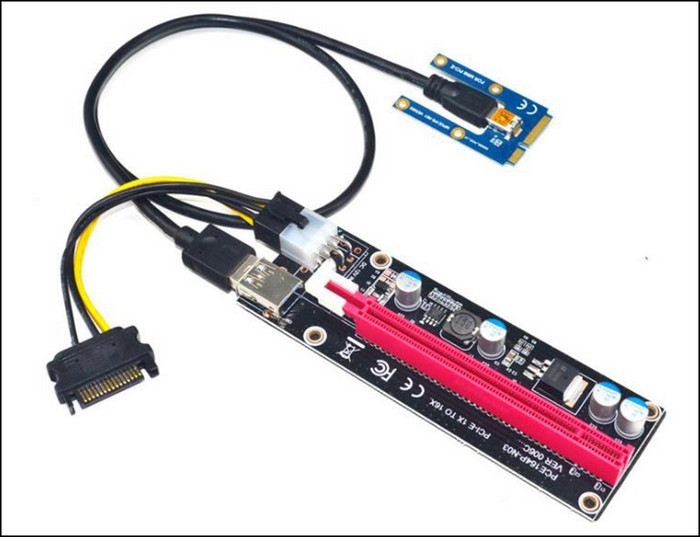
This mini PCIe to PCIe x16 connector uses only a single PCIe lane. As a result, it’ll limit the bandwidth and surely bottleneck the installed graphics card. Additionally, it’s not a plug-and-play type because you must need a desktop PSU to power up the GPU.
Though you can install an external GPU to a laptop with this converter, you’ll get a slow GPU bandwidth. This procedure is cheap but problematic at the same time. So, I won’t recommend this setup.
2. M.2 NVMe to PCIe x16 eGPU Kit
This is another kit similar to the previous one, but instead of using the mini PCIe slot, it uses the M.2 NVMe to PCIe x16 slot. But it’s faster than the mini PCIe to PCIe x16 eGPU Kit. The laptop’s M.2 NVMe slot uses only 4 PCIe lanes, and so does this M.2 NVMe to PCIe x16 eGPU kit.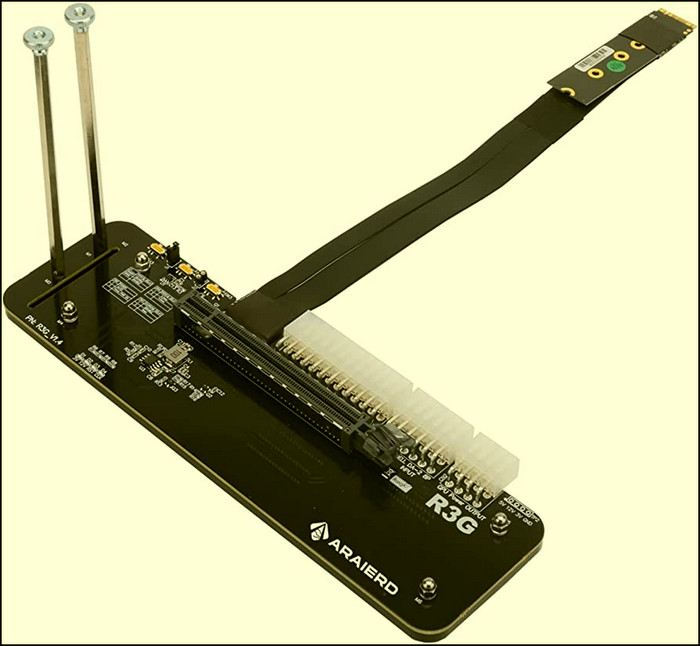
So, it’s not a match for the traditionally required graphics bandwidth because desktop GPUs use 16 or 8 lanes. As a result, you’ll face GPU bottlenecking issues with this kit, and it’s expensive too. So, I am not recommending this either.
3. Thunderbolt 3.0 eGFX Dock
Thunderbolt 3.0 eGFX dock kit is perfect for adding an external desktop-grade GPU. It’s super fast and highly reliable too. You can find Thunderbolt 3.0 eGPU Docks in the market, and renowned brands are selling them.
Among the eGPU docks, the hyped ones are as follows:
- Cooler Master MasterCase NC100
- Cooler Master MasterCase EG200
- PowerColor Devil Box
- Razer Core
- AKiTiO Node Titan.
These docs are plug-n-play type. So, you only need to connect the Thunderbolt port connector from the Dock to the laptop. And this kit has a built-in PSU inside the Dock, so you must power it separately.
You’ll find Thunderbolt 3.0 ports in high-end gaming and business-class laptops. These ports are USB Type C but more powerful than the traditional Type-C ports. This port alone can provide a PCIe slot, a DisplayPort, and sometimes work as a DC power port.
A Thunderbolt 4.0 port can transfer data with a blazing-fast speed of up to 40Gbps. So, look for a Thunderbolt port if you have a high-end laptop. Remember, every Thunderbolt port is a Type-C port, but not all Type-C ports are Thunderbolt.
If the Type-C port is Thunderbolt, you’ll see a Lightning Bolt logo beside it. All you need to do is to install the graphics card in the Dock and connect the thunderbolt connector to the laptop’s port. Then give power to the Dock.
And boom! You just installed an external eGPU on your laptop. For testing purposes, I have tried Thunderbolt 3.0 eGFX Dock with my Dell latitude 7390 2-in-1 laptop. Also, I installed the GTX 1650 card in it. The result was mind-blowing because now I can play almost every AAA-titled game in it.
FAQs
How to know which GPU I have on my laptop?
If you have a dedicated graphics card on your laptop, go to Windows Device Manager > Display Adapters. From there, you’ll see your discrete GPU’s model name.
Which are the NVIDIA laptop GPUs with MXM connectors?
There are several Nvidia GPUs that have MXM connectors, and such mobile graphics cards are GTX 1060, GTX 1070, GTX 1080, RTX 2060, RTX 2080, and so on.
What is the latest Thunderbolt port version?
Thunderbolt 4.0 is the latest version, and it supports transferring data up to 40Gbps.
Final Thoughts
So, it’s clear to you that you can’t upgrade a laptop GPU, whether it’s integrated or discrete. However, some high-end gaming laptops support GPU upgrades, but those are expensive. Alternatively, you can install an external graphics card on your laptop.
Moreover, it’ll be best to go for another laptop with a more advanced GPU than your current one.
Updating a laptop GPU is more expensive than buying a new one.
That’s all I have to share. For more info, knock me in the box below.


